The purpose of this strip is to create two crimps with arms attached that cause two separate discs, one atop the other, to rotate in opposite directions.
This strip creates a platform 1/2 inch high on one side of the card. A step, if you like. Considering the two pages as a single card, one end of the strip is attached to near the center of the card in this case the recto side of the card. The distance is determined arbitrarily by the content, here, a snake that is turning, so the rotation of the two discs and the head of the snake plus the thing that the snake is striking are all considered in arriving at the length of the strip, the height of the step, and the location of the tab. It's all a bit intuitive. The other end of the strip is glued to the opposite side of the central fold, the verso side of the card, exactly 1/2 inch away from the central fold. So now a step is formed exactly 1/2 inch high when the card is held with one side straight up like a book on the table exactly half opened at 90° it will be a step glued into place with two tabs, a fully compressed accordion when closed and fully extended when opened.
Two crimps facing each other are creased into the outer corners of the step. Tiny paper arms are attached to 1/2 of each crimp. Opening and closing the card causes the crimps to open and close which in turn causes both tiny arms to swing 45° in opposite directions. Discs attached to the arms appear to rotate by 45°. The combined movement of two discs rotating in opposite directions has the visual impact of 90° of total snake movement and that is considerable for a simple pop-up card.
A snake pattern is drawn on the disks so that when they turn it appears as if the snake is uncoiling. It's eerie! The bottom disc is slightly larger than the top disk so that its edges show. The center of the bottom disk is cut out, like a donut, a torus, so that the arm attached to the top disc can pass through. Now, why not just glue the discs directly to the crimps? Try it and see, the crimps fold inward and must take the discs with them. The arms allow the discs to lay approximately flat although the discs tend to tilt when rotating. When you see the discs rotate one atop the other in opposite directions with no obvious force applied, it boggles the mind, especially with a snake pattern drawn on it, and looking exactly, and I mean exactly like a snake silently unwinds. The crimp device can be used for a ton of things. Whoever invented this device was a devious mind indeed.
So there's that. One device, two movements.
The second device disappears behind the card. A stiff paper arm pulls and shoves back and forth like a piston with the movement of opening and closing the card. The stiff arm moves another arm like a lever. In this case the arm affects a paper lever with an offset pivot much like a piston attached to one side of a see-saw with the fulcrum offset and unequal sides. The arcs produced by the arms of the pivoting lever are the same lengths, but there is more paper on the bottom and a longer arm so then an apparent longer arc but that is only because the fulcrum is offset, if it were a fulcrum. I think. What do I look like, Euclid, over here?
Like the strip in the fist mechanism, the stiff paper bar, the working arm, of the second mechanism is attached to the opposite side of the card. That is, the content is on the verso leaf but the arm is hinged to recto leaf. This is what makes the arm move when the card is opened and closed. The arm pulls when the card is opened, and it shoves back when the card is closed. So you can see the stress put on the tiny paper hinge. For this reason the card stock is doubled.
This photo is getting a little bit ahead of things, but it shows the stiffened arm attached to the recto side of the card and disappearing through a slot on the verso side of the card. The arm is located underneath the snake. So you will see the two mechanisms operating in different directions. The platform for the snake is attached 1/2 inch from the central fold on the verso side, and the post for the other two snakes is attached 1/2 inch from the central fold on the recto side. This is the essential idea of both mechanism whether on top of the card or behind it: one side of the card forces movement on the opposite side of the card. The sooner you accept this then all the sooner you enter the Halls of Advanced Pop-Uppery. I'm telling you, this is not seen anywhere else online or in any books that I am aware of.
Now the back of the card where the action takes place. Originally I intended for the stiff working arm to shove two separate arms in opposite directions. So I made two arms and their paper pivots that fit through their little holes. But then I realized I could get arcs moving in opposite directions with a see-saw type construction instead. So I glued together the two arms at the pivoting circle, one hole directly above the other hole. (It turns out this had to be repeated later on so the whole thing was cut as a single unit. That too turned out to be too weak so the whole thing was redone a third time with a reinforced see-saw. These pictures are showing the original thing)
One end of the see-saw passes through a slot cut into the working arm. The pivot point in the center of the hole in the see-saw is determined and marked on the page with a pencil through the see-saw hole.
The clever little turning pin made of paper is glued to the spot marked by the pencil. This little circle with the X drawn on it like a nuclear hazard sign, cut so that two propeller-looking things are glued to the card back and the other two propeller-looking flaps are creased, folded and passed through the hole of see-saw arm is not my invention. I discovered it by fixing a few pages ofKirby the Easter Dog by George White and glueing them back together.
This device is going to be very useful.
You can see how the working arm behaves as a piston operating on the longer see-saw arm. The longer arm will make a longer more dramatic arc.
Remember, this is the back of the card. Card closed ↑ the top see-saw arm to the far left position (which is far right on the opposite side of the card). Card opened ↓, see-saw arm to the far right position (far left position on the opposite side of the card).
The extremes of see-saw arm movement are marked ↓.
The content on the front side of the card will be snakes striking at grasshoppers. Their placement is mostly intuited. Whatever difficulty arises must be dealt with later or maybe even another fresh start. Slits must be cut for the arcs of the see-saw tips to swing on the front side of the card. A mark is made on both tips of the see-saw and traced as the card is opened and closed ↓ in order to mark the arc.
The arcs are cut ↑. Yikes! and the see-saw arms are pushed through to the other side. Here is the same picture ↓ again already shown above to point out the working arm attached to the opposite leaf but now used to show the tips of the see-saw arms poking through their arc slits. Content is attached to the tips, in this case, snake heads striking at grasshoppers. Content is also drawn all around the arc, the bodies of the snakes and the little grasshoppers being struck.

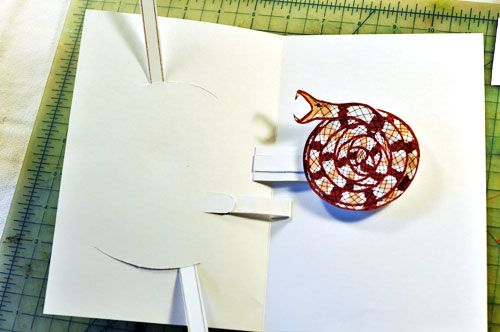



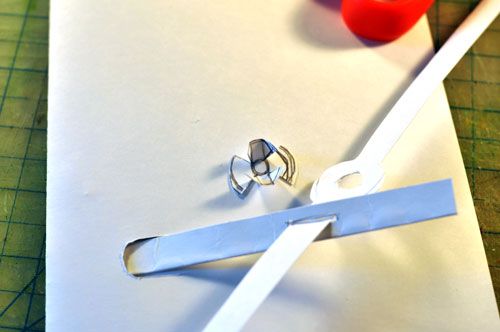
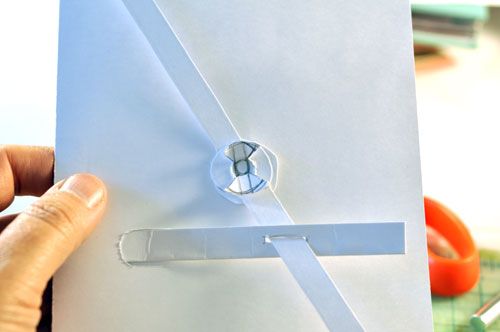
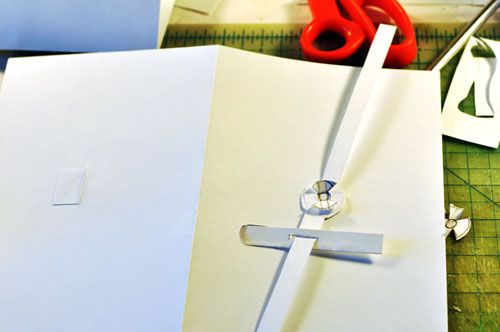
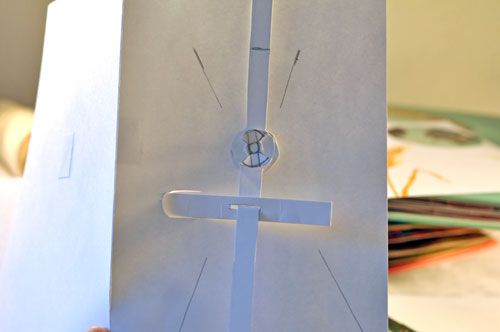
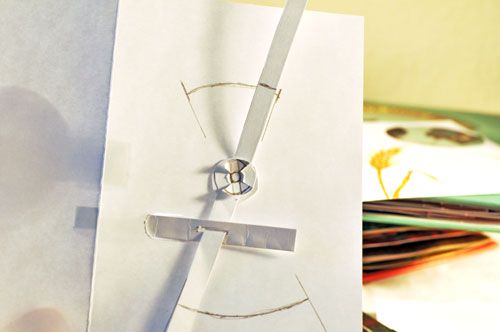
No comments:
Post a Comment